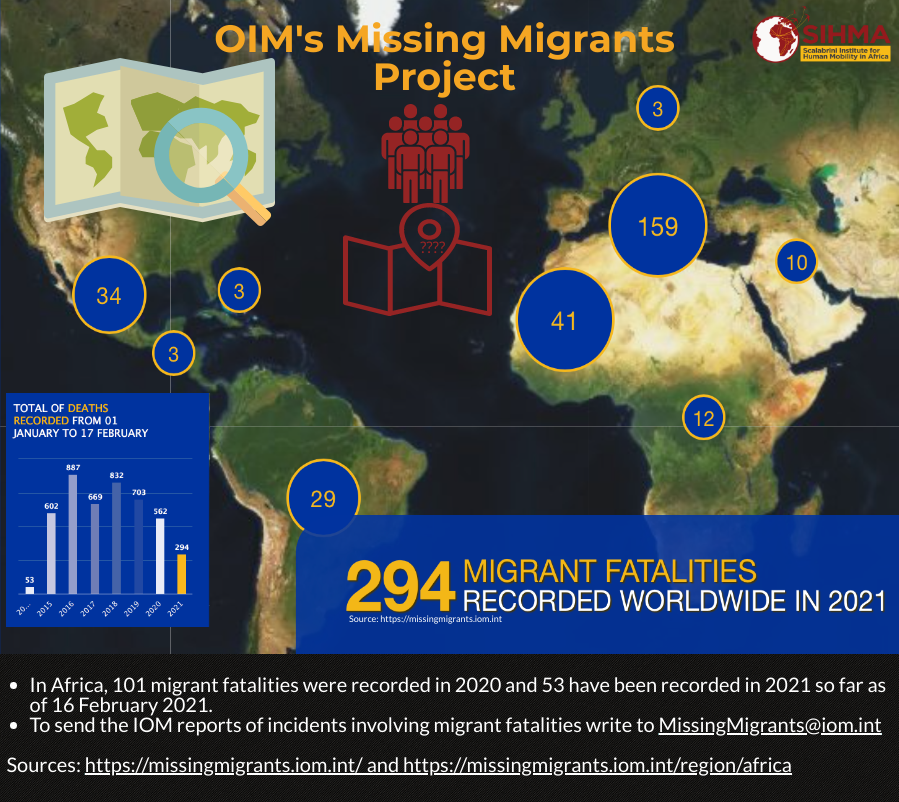
Missing Migrants and IOM Global Migration Data Analysis Centre (GMDAC) webinar
Did you know migrants are facing many challenges including locating their loved ones who have gone missing?
There are many migrants traveling with little to no documentation. Without documentation it is hard to find these individuals and locate loved ones if they go missing. Migrants are dying in the sea, in deserts (especially in the Sahara in the African Context (1)) and at various unofficial border posts because of the increase in monitoring and border policing at official border posts. The policing of borders and the risk of being denied entry has heavily influenced the alternative routes migrants take to reach their destination and some go missing. Many routes are very dangerous for the migrants with risks of drowning in rivers or at sea (2), dehydration in deserts (1), attacks from wildlife (eg crocodiles in the Limpopo river between south African and Zimbabwe) and/or challenges from smugglers, traffickers and/or security forces at borders.
Countries across the world from Malawi, Zimbabwe, and South Africa to Italy, Central America, and Mexico all have missing migrants that cannot be found. The International Organization for Migration (IOM) launched a campaign known as IOM’s Missing Migrant Project. The project was initiated in 2014, inspired by the disappearance of two ships in the Mediterranean Sea in 2013 (3). The Missing Migrants Project tracks incidents involving migrants, including refugees and asylum-seekers, who have died or gone missing in the process of migration towards an international destination (4).
In 2020, the Restoring Family Links Network of the Red Cross and Red Crescent Movement in collaboration with the IOM took on a caseload of over 100 migrants in Southern Africa and found one-third of them, in some cases after searching for 44 years. Nonetheless, there is still a lot to do. The data on migrant deaths and disappearances is incomplete in many regions of the world, including in Sub- Saharan. Since January to August 2019, an estimated that 253 migrants died or went missing along the migration routes in Sub-Saharan Africa although this is most likely to be underestimated particularly given the prominence of irregular migration in the region (5).
IOM Global Migration Data Analysis Centre (GMDAC) hosted a very informative webinar on December 4th, 2020, which James Chapman from SIHMA attended (11). In the seminar one point that presenters shared was that due to the Covid-19 pandemic, there are less IOM colleagues on ground causing a corresponding decrease in collection of witness statements. Additionally, understandably, the media has also shifted focus to address Covid-19 news rather than missing migrants, which has also affected sourcing information. Through all of this, data has been limited especially in search and rescue in the Mediterranean Sea. Another issue observed was that although many people may not know about these missing migrants, there are many missing migrants in on the Southern African route, across the continent and at sea, and in some cases despite investigation the identity of the dead remains unknown. For instance, many migrants found near the South Africa - Zimbabwe border are declared as paupers with unknown identity and buried by the state.
IOM News and presenters at the webinar mentioned that, “the Mothers’ Caravan [a group of mothers of Central America cross Mexican territory in search for their children] was joined in Mexico City by mothers from other continents, with an aim of building a transnational movement to remind the international community that one disappearance, one death, is one too many” (6). Most of these families, missing their loved ones, will wear the photograph of their loved one around their neck, in hope for someone to recognize or identify them and their whereabouts.
There were 567 migrant fatalities recorded by the IOM’s Missing Migrant Project in 2020 and in 2021 as of 16 February, 294 migrant fatalities have been recorded (4). On the African Continent 101 migrant fatalities were recorded in 2020 and 53 have been recorded to date in 2021 (7). The causes of death for those recorded in 2021 were primarily dehydration and drowning followed by starvation and hypothermia (7). 2020 was a year marked by the death of hundreds of North African and Middle Eastern migrants at sea and in January 2021, 43 migrants died and 10 managed to survive whilst crossing the Mediterranean Sea by boat, towards the southern coasts of Europe (8). This tragedy marks the first incident in the Mediterranean reported in 2021 (8).
The Missing Migrants Project assists in searches for missing family members through referring you to Restoring Family Links Network of the Red Cross and Red Crescent Movement (9). If seeking to obtain support from members of the network in searches people are encouraged to approach Restoring Family Links Services in the country where you live (9). The service is active in 190 countries and the country office addresses may be found on the dedicated website of the Red Cross and Red Crescent Movement (10), (9). The first step is always sending a tracing request which is completed by a member of the Red Cross or Red Crescent Movement during a face-to-face interview with a family member of the missing in your country of residence. To send the IOM reports of incidents involving migrant fatalities and for other enquiries please write an email to MissingMigrants@iom.int (9).
James Chapman and Yolanda Gonzalez
SIHMA SIHMA
Project Manager Research and Communication Intern
Sources:
- No one talks about what it’s really like” – risks faced by migrants in the Sahara Desert (https://missingmigrants.iom.int/%E2%80%9Cno-one-talks-about-what-it%E2%80%99s-really-%E2%80%9D-%E2%80%93-risks-faced-migrants-sahara-desert )
- https://missingmigrants.iom.int/west-and-central-africa-%E2%80%94-irregular-migration-routes-europe-january-%E2%80%94-november-2020
- https://missingmigrants.iom.int/about
- https://missingmigrants.iom.int/
- https://www.iom.int/news/first-database-migrant-deaths-and-disappearances-sub-saharan-africa-helps-families-heal
- https://www.iom.int/news/forgotten-migrant-caravan-historic-launch-global-movement-families-missing
- https://missingmigrants.iom.int/region/africa
- https://www.voanews.com/africa/un-reports-43-dead-after-migrant-ship-sinks-libyan-coast
- https://missingmigrants.iom.int/report-missing
- https://familylinks.icrc.org/en/Pages/home.aspx
- https://sihma.org.za/Blog-on-the-move/iom-s-webinar-on-missing-migrant-project-stakeholder-engagement-workshop-in-the-southern-africa-region
Categories:
Tags:

